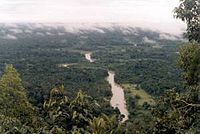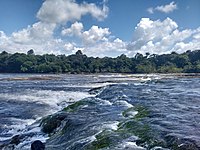North Region, Brazil
North Region
Região Norte | |
|---|---|
US$ 104.634 billion) | |
| HDI | |
| • Year | 2014 |
| • Category | 0.730 – high (4th) |
| • Life expectancy | 71 years (4th) |
| • Infant mortality | 25.8 per 1,000 (2nd) |
| • Literacy | 88.7% (4th) |
| Time zones | UTC−03:00 (BRT) |
| UTC−04:00 (AMT) | |
| UTC−05:00 (ACT) | |
The North Region of Brazil (
Its demographic density is the lowest in Brazil considering all the regions of the country, with only 3.8 inhabitants per km2. Most of the population is centered in urban areas.
The North is home to the Federal University of Amazonas and the Federal University of Pará, among others.
History
The first inhabitants of the North Region, as in the rest of Brazil, were the Native Brazilians, who shared a diverse number of tribes and villages, from the pre-Columbian period until the arrival of the European people.[2]
The Spaniards, among them Francisco de Orellana, organized exploratory expeditions by the Amazon River to know the region. After long journeys alongside Francisco de Orellana, Gonzalo Fernández de Oviedo y Valdés wrote a letter addressed to Cardinal Pedro Bembo in Venice, extolling the fauna and flora existing in the region at the time of the expedition.[2]
The 17th century marked the arrival of the
Some of the Region's oldest towns: Bragança, Xapuri, Tefé, Natividade and Amapá.[3] In order to work on rubber extraction, Brazilians from other states, mainly from the Northeast Region, moved to the region. Also many Japanese families came to work in the agricultural colonies.
During the 1960s, 1970s and 1980s, military governments implemented a major plan to integrate the region with other regions of Brazil, including the construction of several highways (such as the
Settlement

The territorial division into countries does not necessarily coincide with the indigenous occupation of the geographical space; in many cases, there are people living on both sides of international borders, which were created long after they were already in the region.
From the beginning of the colonization from the 17th century to the present day, the inhabitants of
After
Geography


The
The diversity of plant species is the highest on earth with some experts estimating that one square kilometre may contain over 75,000 types of trees and 150,000 species of
Some latitudes can create a region with hot and humid climates. The existence of heat and the enormous liquid mass favor evaporation and make the region a very humid area.
Dominated by an
The Amazonian heat provides an area of low latitude that attracts masses of polar air. Occurring in winter, the effect of "friagem" lasts a week or so.
Political Subdivisions

| City | Population (2016) |
|---|---|
| Manaus | 2,094,391 |
| Belém | 1,446,042 |
| Porto Velho | 511,219 |
Ananindeua |
510,834 |
| Macapá | 465,495 |
| Rio Branco | 377,057 |
| Boa Vista | 326,419 |
| Palmas | 279,856 |
Culture
With its own folklore, the main attractions are the Parintins Folklore Festival, Círio de Nazaré in Belém, Rio Branco and Macapá; Sairé Festival, in Santarém, ExpoAcre (the largest in the North region)[10][11][12][13] and typical dances, Marujada, Carimbó, Brazilian Calypso, Tecno brega and Cirandas such as Samba lelê and others.
In the region, there are some of the most beautiful theaters and palaces in Brazil: The Amazon Theatre, located in Manaus, Palácio Rio Branco, in Rio Branco, Palácio Senador Hélio Campos, in Boa Vista, Teatro das Bacabeiras, in Macapá and the Peace Theatre, located in Belém. The gastronomic culture of the northern region of Brazil is quite rich, has Indigenous, African and Portuguese roots, in addition to other influences from both within Brazil and other cultures outside the country, the strong Amazonian indigenous influence in its main dishes is remarkable, among the main highlights are delicacies such as duck in tucupi sauce, maniçoba, tacacá and a menu of a wide variety of species of Amazonian fish, such as pirarucu, tambaqui, jaú, piramutaba, among other species; a huge menu of fruits, such as the local açaí, pupunha, tucumã, cupuaçu, buriti, abiu, urucu, Malay apple, cumaru, guaraná, and ingá, among other fruits. The whole region has a rich variety of ingredients, but also foods based on cassava such as water flour, uarini flour, tapioca flour, tapioca gum, tucupi, among others.
Ethnic groups
The population of northern Brazil is largely made up of Caboclos, descendants of Native Brazilians and Europeans - mostly Portuguese, French and Spanish.
North of Brazil has received and continues to receive large migration of people from
Race (2022)[14]
| |
|---|---|
| Multiracial | 67.2% |
White |
20.7% |
Black |
8.8% |
| Amerindian | 3.1% |
Asian |
0.2% |
Economy
The economy of the North Region is essentially based on the vegetal plantation and extraction, such as
Infrastructure
Educational Institutions
- Federal University of Pará (UFPA)
- Federal University of Western Pará (UFOPA)
- Federal University of Southern and Southeastern Pará (UNIFESSPA)
- Pará State University (UEPA)
- Federal University of Acre (UFAC)
- Federal University of Amazonas (UFAM)
- Amazonas State University (UEA)
- University of Amazon (UNAMA)
- Federal University of Rondônia (UNIR)
- Federal University of Tocantins (UFT)
- Federal University of Amapá (UNIFAP)
- Federal University of Roraima (UFRR)
Transportation
There are only a few highways in the North region. The most important ones are the
Most of the transportation in the region is done by boat or airplane. There are two major airports in the region:
.The Rio Branco International Bus Station offers services to destinations in Peru and Bolivia, the Boa Vista International Bus Station to Venezuela and Guyana.
See also
- Açaí
- Free Economic Zone of Manaus
- Port of Santarém
- Guaraná
- Brazil Nut
- Central Market of Macapá
References
- ^ "PIB por Unidade da Federação, 2021". ibge.gov.br.
- ^ a b c d "História da Região Norte do Brasil". Hjo Brasil. Archived from the original on 6 June 2013. Retrieved 28 May 2013.
- ^ "Página - IPHAN - Instituto do Patrimônio Histórico e Artístico Nacional".
- S2CID 55147576.
- ISBN 0-521-80183-4
- ^ "Amazon Rainforest, Amazon Plants, Amazon River Animals". World Wide Fund for Nature. Retrieved 2007-11-26.
- ^ Da Silva et al. 2005. "The Fate of the Amazonian Areas of Endemism". Conservation Biology 19 (3), 689-694
- S2CID 84691981.
- ^ Photos / Pictures of the Amazon Rainforest
- ^ "Peruvian businessmen close deals worth US$5.8 million at Brazil Expoacre 2015".
- ^ "In Rio Branco, the 46th ExpoAcre brings together more than 100 zebus on the track".
- ^ "Productores urubambinos participan en la ExpoAcre 2022, una de las ferias más importantes de Brasil (Urubamba producers participate at ExpoAcre 2022, one of the most important fairs in Brazil)". Government of Peru.
- ^ "Peru: Puno's entrepreneurs participate at Expoacre 2022 in Brazil".
- ^ "Censo 2022 - Panorama".






